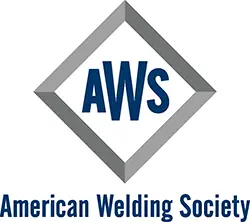AWS: American Welding Society

AWS, the American Welding Society, is a nonprofit organization that develops and publishes standards that apply to welding and related joining disciplines. Headquartered in Miami, United States, AWS standards are spread by its over 65,000 worldwide members, a significant portion of which are located within the United States. AWS is heavily involved in educational initiatives, with many conferences around the world, student scholarships and a wide variety of courses. AWS also serves as the administrator for the U.S. TAGs (United States Technical Advisory Group) to ISO/TCs 44 and 167 (International Organization for Standardization/Technical Committee) and to many of the subcommittees for ISO/TC 44.
Below are AWS's best-selling standards. To find additional standards, please use the search bar above.
AWS D1.1/D1.1M:2020
Structural Welding Code - Steel
This code covers the welding requirements for any type of welded structure made from the commonly used carbon and low-alloy constructional steels. Clauses 1 through 11 constitute a body of rules for the regulation of welding in steel construction. There are eight normative and eleven informative annexes in this code. A Commentary of the code is included with the document.
AWS D17.1/D17.1M:2017-AMD2
Specification For Fusion Welding For Aerospace Applications
Amendment 2: This specification provides the general welding requirements for welding aircraft and space hardware. It includes but is not limited to the fusion welding of aluminum-based, nickel-based, iron-based, cobalt-based, magnesium-based, and titanium-based alloys using electric arc and high energy beam processes. There are requirements for welding design, personnel and procedure qualification, inspection, and acceptance criteria for aerospace, support, and non-flight hardware. Additional requirements cover repair welding of existing hardware. A commentary for the specification is included.
AWS A2.4:2020
Standard Symbols for Welding, Brazing, and Nondestructive Examination
This standard establishes a method for specifying certain welding, brazing, and nondestructive examination information by means of symbols, including the examination method, frequency, and extent. Detailed information and examples are provided for the construction and interpretation of these symbols.
AWS D1.6/D1.6M-2017
Structural Welding Code - Stainless Steel
This code covers the requirements for welding stainless steel structural assemblies.
AWS D14.1-D14.1M-2005
AWS D14.1/D14.1M:2005 SPECIFICATION FOR WELDING OF INDUSTRIAL AND MILL CRANES AND OTHER MATERIAL HANDLING EQUIPMENT
Requirements are presented for the design and fabrication of constructional steel weldments that are used in industrial and mill cranes. lifting devices and other material handling equipment. Requirements are also included for modification. weld repair. and postweld treatments of new and existing weldments. Filler metal and welding procedure guidelines are recommended for the applicable base metals. which are limited to carbon and low-alloy steels. Allowable unit stresses are provided for weld metal and base metal for various cyclically loaded joint designs.
AWS D17.1/D17.1M:2017-AMD1
Specification for Fusion Welding for Aerospace Applications
This specification provides the general welding requirements for welding aircraft and space hardware. It includes but is not limited to the fusion welding of aluminum-based, nickel-based, iron-based, cobalt-based, magnesium-based, and titanium-based alloys using electric arc and high energy beam processes. There are requirements for welding design, personnel and procedure qualification, inspection, and acceptance criteria for aerospace, support, and non-flight hardware. Additional requirements cover repair welding of existing hardware.
AWS D1.3/D1.3M:2018
Structural Welding Code - Sheet Steel
This code covers the requirements associated with welding sheet steel having a minimum specified yield point no greaterthan 80 ksi [550 MPa]. The code requirements cover any welded joint made from the commonly used structural quality low-carbon hot rolled and cold rolled sheet and strip steel with or without zinc coating (galvanized). Clause 1 includes general provisions, Clause 4 design, Clause 5 prequalification, Clause 6 qualification, Clause 7 fabrication, and Clause 8 inspection.
AWS A3.0M/A3.0:2020
Standard Welding Terms and Definitions Including Terms for Adhesive Bonding, Brazing, Soldering, Thermal Cutting, and Thermal Spraying
This standard is a glossary of the technical terms used in the welding industry. Its purpose is to establish standard terms to aid in the communication of information related to welding and allied processes. Since it is intended to a comprehensive compilation of welding terminology, nonstandard terms used in the welding industry are also included. All terms are either standard or nonstandard. They are arranged in word-by-word alphabetical sequence.
AWS C7.4/C7.4M:2017
Process Specification and Operator Qualification for Laser Beam Welding
This specification on laser beam welding discusses applicable specifications, safety, requirements, fabrication, quality examination, equipment calibration and maintenance, approval of work, and delivery of work.





